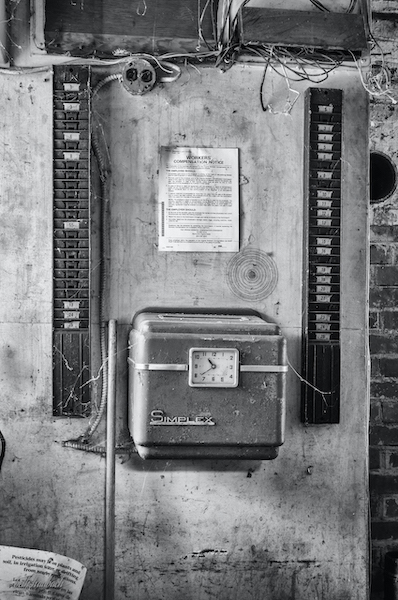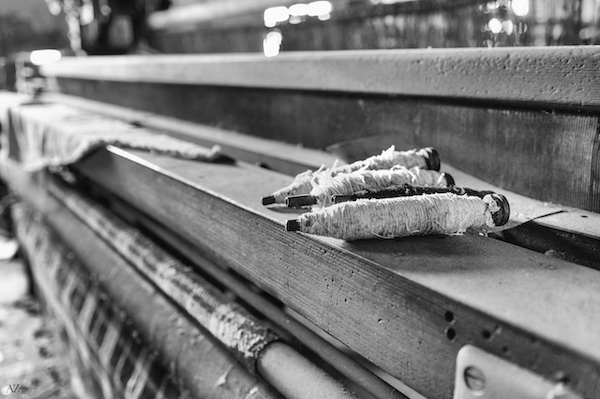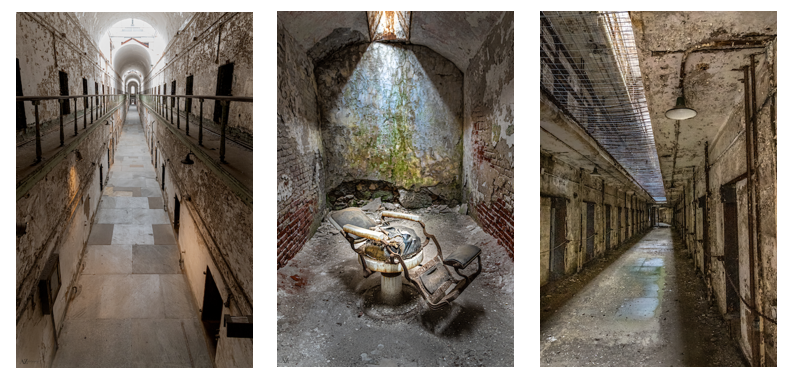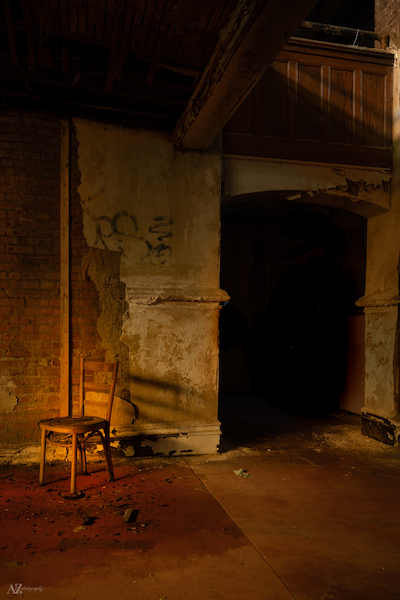 I’ve always liked "old stuff:” old, oxidized tools; old dusty books; old vehicles being reclaimed by rot and rust; old deteriorating buildings…you get the point. My imagination is set on fire when I look at abandoned buildings or vehicles. I have to wonder, “What happened here? Why were these buildings or cars and trucks simply left to decay?" Most of the buildings I’ve been in look as if the employees simply walked out one day and vanished. Many of the buildings I’ve ventured into served a singular purpose and often contain some interesting and unusual machinery. As I stand looking at vehicles in a field or at ancient machinery in a factory, I can only imagine the lives of the people who worked in these spaces or drove these vehicles.
I’ve always liked "old stuff:” old, oxidized tools; old dusty books; old vehicles being reclaimed by rot and rust; old deteriorating buildings…you get the point. My imagination is set on fire when I look at abandoned buildings or vehicles. I have to wonder, “What happened here? Why were these buildings or cars and trucks simply left to decay?" Most of the buildings I’ve been in look as if the employees simply walked out one day and vanished. Many of the buildings I’ve ventured into served a singular purpose and often contain some interesting and unusual machinery. As I stand looking at vehicles in a field or at ancient machinery in a factory, I can only imagine the lives of the people who worked in these spaces or drove these vehicles.
I’m also drawn to the beautiful designs and effects that appear as nature takes over causing paint to peel, metal to rust, and wood to decay. The opportunity to capture what may be the last breath of a disintegrating vehicle or crumbling building is something I jump at! Whether capturing an entire subject or an abstract portion of it, the creative and photographic possibilities seem endless.
Deciding how to photograph in these different spaces is dependent on the light and any rules imposed by the venue (i.e., some places do not allow tripods, etc). Obviously, outdoor shooting provides more light to work with than indoors but still, a bright sunny day brings challenges that can be difficult to work around. Often in abandoned buildings the only light is natural light, which results in bright highlights (think windows) and deep, dark shadows. This becomes a perfect opportunity to do HDR photography. As such, I will bracket my shots and then process them using HDR editing software.
 Before even taking my camera out of the bag, I will walk around and through the area I’m planning to shoot to get a “lay of the land” and closely study the space. Once the camera goes to my eye, what I “see” can be limited. I start “wide,” using a Sigma 10mm-20mm wide-angle lens, and capture the entire scene from various angles. Then, I either change lenses to a Sigma ART 18mm-35mm f/1.8 or to my Nikon 24mm-120mm f/4. Although the 18-35mm isn’t as wide than the 10mm-20mm, it performs phenomenally well in low light and is a super fast and sharp lens. Additionally, the wide aperture of the Sigma ART lens provides great depth of field and a lot of creative options. If I can’t get close to my subject, I might use a 70mm-300mm zoom; although the lack of light, even when using a tripod, can be problematic with this lens. These old spaces provide great opportunities to practice macro photography, so I’ll usually finish using a Nikon Micro-NIKKOR 85mm f/3.5 lens in order to get in tight.
Before even taking my camera out of the bag, I will walk around and through the area I’m planning to shoot to get a “lay of the land” and closely study the space. Once the camera goes to my eye, what I “see” can be limited. I start “wide,” using a Sigma 10mm-20mm wide-angle lens, and capture the entire scene from various angles. Then, I either change lenses to a Sigma ART 18mm-35mm f/1.8 or to my Nikon 24mm-120mm f/4. Although the 18-35mm isn’t as wide than the 10mm-20mm, it performs phenomenally well in low light and is a super fast and sharp lens. Additionally, the wide aperture of the Sigma ART lens provides great depth of field and a lot of creative options. If I can’t get close to my subject, I might use a 70mm-300mm zoom; although the lack of light, even when using a tripod, can be problematic with this lens. These old spaces provide great opportunities to practice macro photography, so I’ll usually finish using a Nikon Micro-NIKKOR 85mm f/3.5 lens in order to get in tight.
I would not recommend venturing alone into abandoned spaces or fields for a host of reasons. Ideally, you want someone to know exactly where you are and be able to help immediately if you run into trouble, be it an angry landowner, injury, snakes, or other animals. To date, I’ve always been with at least one other person, and more often, part of a group.
One of my first true forays into abandoned building photography was in the Spring of 2017. I was invited to join a group of photographers at an old seed washing factory (yep, that’s actually a thing!) in rural Virginia. The building was owned by one of the photographer’s friends, who gave us the run of the place. Admittedly, it was a little dangerous in that the building was pretty decrepit, so being with a group of people was somewhat comforting. I was in the company of several photographers who were much more experienced than I was at the time, providing many invaluable learning experiences for me.
 To find other photographers with similar interests, Meetup events can be a good resource. As a result of one of these events, a good photographer friend and I discovered, and subsequently visited, a truck “graveyard” near Richmond, Virginia. Another event landed us at Waterside Woolen Mill located close to Breezewood, PA. Both of these locations were wonderful opportunities to practice proper exposure, bracketing, composition, HDR photography, and even a little light painting.
To find other photographers with similar interests, Meetup events can be a good resource. As a result of one of these events, a good photographer friend and I discovered, and subsequently visited, a truck “graveyard” near Richmond, Virginia. Another event landed us at Waterside Woolen Mill located close to Breezewood, PA. Both of these locations were wonderful opportunities to practice proper exposure, bracketing, composition, HDR photography, and even a little light painting.
Eastern State Penitentiary (ESP), in Philadelphia, is one place you could go by yourself. Although ESP is run-down and falling apart, it is a tourist attraction. “Eastern State Penitentiary was once the most famous and expensive prison in the world, but stands today in ruin, a haunting world of crumbling cellblocks and empty guard towers. Known for its grand architecture and strict discipline, this was the world's first true penitentiary, a prison designed to inspire penitence, or true regret, in the hearts of prisoners.” (https://www.easternstate.org/about-eastern-state). I had a grand time earlier this year roaming through this massive structure while taking photographs.
Additionally, if you Google “Abandoned Buildings in Virginia or Maryland,” you will get all sorts of results. Atlas Obscura website almost always pops up at the top of the list and is usually a fount of information. One of the great things about this site is the “Know before you Go” section of each entry. While a location may potentially look like a good place to go, the information in this section will let you know the status of entry and other pertinent information about that specific location.
Eastern State Penitentiary, the Trans-Allegheny Lunatic Asylum in West Virginia, and the Pennhurst Asylum near Philadelphia, are a few places to consider. Contact information for these sites, and other interesting places to photograph, are listed on Capital Photography Center’s Resource page: https://capitalphotographycenter.com/resources.
Some of my best photography has been done at old or abandoned buildings. Subsequently, many of my favorite images have been the results of these trips. Additionally, I’ve met some amazing photographers who have generously shared their knowledge and experience. Exploring these locations is a look back in time and if the walls of these old buildings could talk, I have no doubt they would tell some amazing stories!
Article and images by Beth Haubach. More of Beth's work can be seen on her website, A 2 Z Photography.

